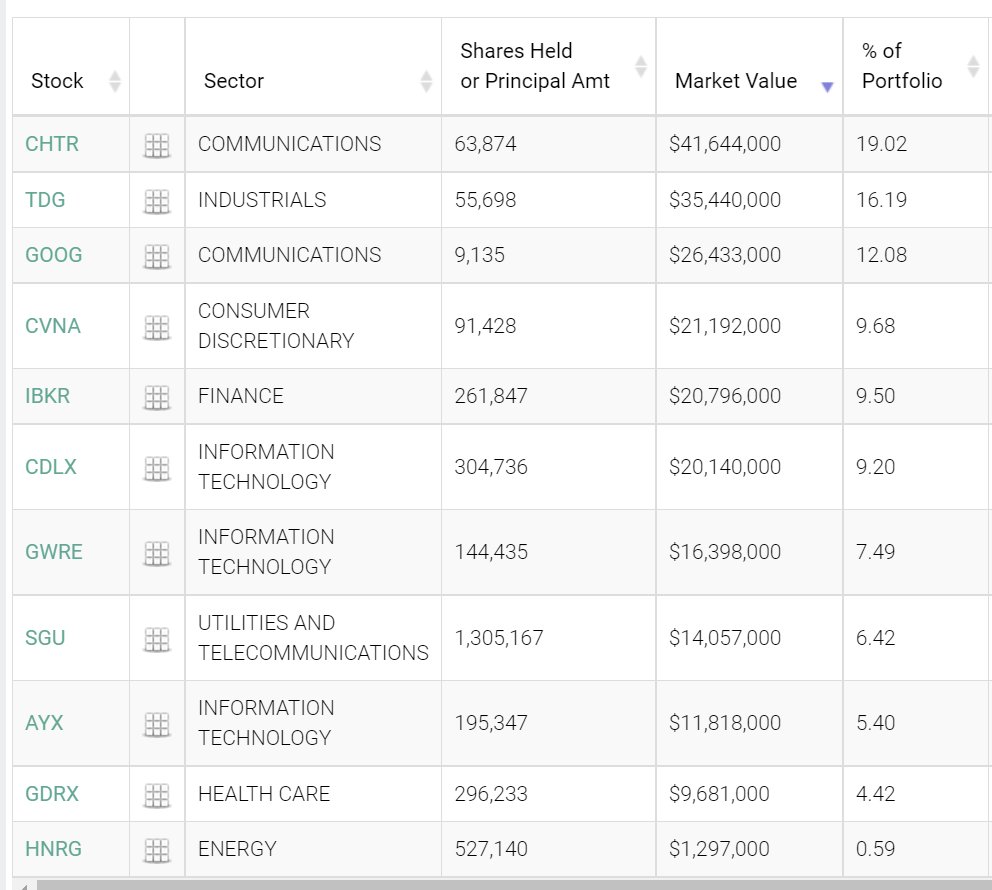Bryan Lawrence started Oakcliff Capital on 1 June 2004.
Since inception, his total returns after fees were 718% as compared to S&P 500 returns of 392%.
He did that while holding 16% of his portfolio as cash (on average)
Here are his frameworks:
Since inception, his total returns after fees were 718% as compared to S&P 500 returns of 392%.
He did that while holding 16% of his portfolio as cash (on average)
Here are his frameworks:

He classifies his companies into 3 buckets
1) Pricing Power / Mission Critical products - $CHTR $TDG
2) Multi-sided Markets - $CVNA $CDLX
3) Low-cost providers $IBKR $BFIT
1) Pricing Power / Mission Critical products - $CHTR $TDG
2) Multi-sided Markets - $CVNA $CDLX
3) Low-cost providers $IBKR $BFIT

5 Questions 💡
1. Do we understand this biz, is it within the circle of competence?
2. Is this a great biz producing durable cash flow? Provide more value vs what it charges?
3. Mgmt alignment?
4. Are valuations cheap relative to the biz's cash flow?
5. Any misconceptions?
1. Do we understand this biz, is it within the circle of competence?
2. Is this a great biz producing durable cash flow? Provide more value vs what it charges?
3. Mgmt alignment?
4. Are valuations cheap relative to the biz's cash flow?
5. Any misconceptions?
Why great biz and not something else?
1. They produce not just durable cash flow (CF), they also produce growing CF which increases the value of biz.
2. They produce predictable CF which makes valuing companies easier. When the market is volatile during stressful periods...
1. They produce not just durable cash flow (CF), they also produce growing CF which increases the value of biz.
2. They produce predictable CF which makes valuing companies easier. When the market is volatile during stressful periods...
... he can buy stocks with confidence
All his time is spent on understanding great businesses.
All his time is spent on understanding great businesses.
Investing is investigative journalism.
Read public filings, new stories, and earnings calls.
See the track record of the mgmt. What they say versus what actually happened
Call customers, competitors, suppliers and ex-employees.
Everything.
Read public filings, new stories, and earnings calls.
See the track record of the mgmt. What they say versus what actually happened
Call customers, competitors, suppliers and ex-employees.
Everything.
20% Internal Rate of Return is the Minimum
If a biz's cash flow per share improves, IRR goes up.
The share price goes up? IRR goes down.
A mistake is made? Exit position.
A position is added when the IRR goes up, subtracted when the IRR goes down.
If a biz's cash flow per share improves, IRR goes up.
The share price goes up? IRR goes down.
A mistake is made? Exit position.
A position is added when the IRR goes up, subtracted when the IRR goes down.
Have a healthy dose of skepticism
When a stock keeps going up, it’s easy and dangerous to fall in love with it. Investors might feel they are smart. But the wrong process with a good outcome is even scarier.
Look for disconfirming evidence and seek new information.
When a stock keeps going up, it’s easy and dangerous to fall in love with it. Investors might feel they are smart. But the wrong process with a good outcome is even scarier.
Look for disconfirming evidence and seek new information.
Thoughts of inflation?
Businesses that can pass off inflation are those that add value to their customers well in excess of the price that it charges them. Some examples include $CHTR, $TDG and $GWRE.
Without TransDigm parts, an airplane cannot fly. Mission critical products.
Businesses that can pass off inflation are those that add value to their customers well in excess of the price that it charges them. Some examples include $CHTR, $TDG and $GWRE.
Without TransDigm parts, an airplane cannot fly. Mission critical products.
Thoughts on volatility?
Human psychology is what it is. Most investors respond irrationally. They buy as prices go up and sell as prices go down. We get to buy from weak hands.
Human psychology is what it is. Most investors respond irrationally. They buy as prices go up and sell as prices go down. We get to buy from weak hands.
SUMMARY:
1. 3 buckets of companies
2. 5 questions framework
3. Buy great companies
4. Invest like an investigator
5. Set high IRR for our companies in our portfolio
More on him:
moiglobal.com/bryan-lawrence…
theinvestorspodcast.com/episodes/beati…
1. 3 buckets of companies
2. 5 questions framework
3. Buy great companies
4. Invest like an investigator
5. Set high IRR for our companies in our portfolio
More on him:
moiglobal.com/bryan-lawrence…
theinvestorspodcast.com/episodes/beati…
https://twitter.com/SlingshotCap/status/1516406315714854917
If you like this type of content content, follow me at @SlingshotCap
I tweet about
- company analysis
- investment concepts
- my investment journey
DMs are open for conversations as well!
I tweet about
- company analysis
- investment concepts
- my investment journey
DMs are open for conversations as well!
• • •
Missing some Tweet in this thread? You can try to
force a refresh











